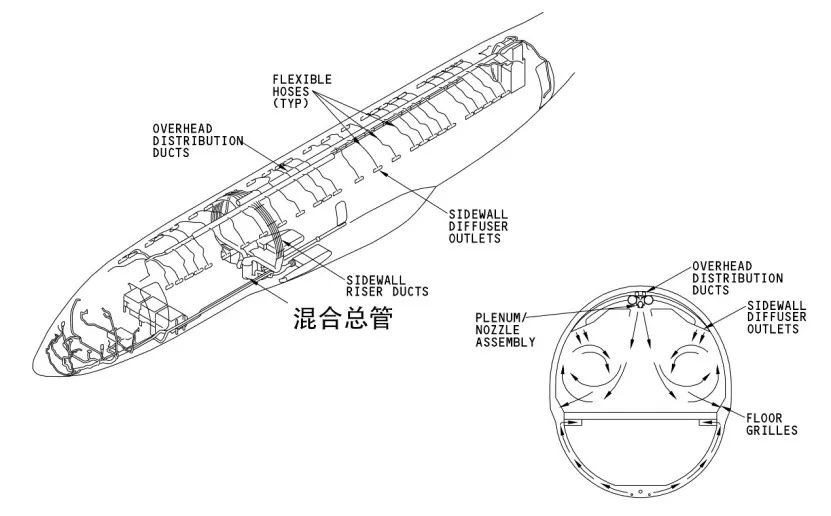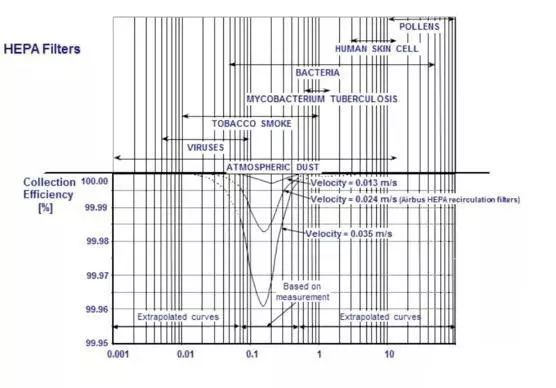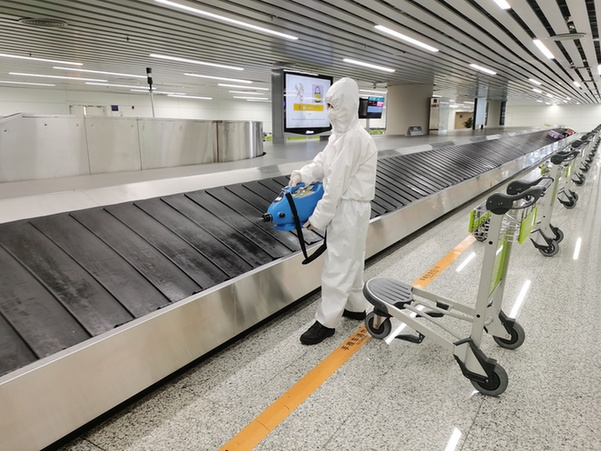The cabin looks very small, does it mean that the aircraft is not easily ventilated and can cause infection? Will the plane even become the "Princess Diamond" in the air? The answer is "NO"!
First, the cabin air is replaced every 2 to 3 minutes, and 20 to 30 times per hour. Aircraft ventilation system mainly makes the air flow up and down. This circulation method can effectively reduce the possibility of virus spreading on the aircraft. The rate of air replacement in the operating room of the hospital is once every 12 minutes, and the replacement rate in ordinary buildings is even lower. Secondly, in air filtration, the aircraft generally uses a "high-efficiency particle filtration" system (HEPA), which can remove particles with a diameter of 0.1 to 0.3 microns in the air, and the removal rate is 99.99%.
Aircraft ventilation system filters 99.99% of viruses
The design of the aircraft has taken into account the ventilation requirements during operation. Under normal circumstances, the aircraft cabin is replaced with air every 2 to 3 minutes, and 20-30 times per hour. There is fresh air in the cabin of the aircraft. The fresh air is mixed with the original air in the cabin filtered by the high-efficiency filter (HEPA) after being cooled by the high temperature and pressure of the engine (or APU). The tuyere blew out and was eventually drawn back through the grille on the side close to the floor. This design feature makes the direction of air flow in the cabin basically vertical, and the air flow in the transverse direction of the fuselage is small, which ensures the cleanliness and freshness of the air in the cabin to the greatest extent. Under normal circumstances, diseases do not pass through the aircraft air conditioning system. Spread inside the cabin.

Most modern Boeing and Airbus aircraft in
service today have HEPA. Boeing pointed out in the maintenance manual that HEPA
can effectively capture 0.003-10 microns particles, and the filtration
efficiency of 0.3 microns pollution particles can reach 99.97%. Airbus also
released technical documents on the outbreak on January 23, 2020, suggesting
that the aircraft's HEPA could filter out 99.99% of viruses and bacterial
particles.
To be intuitive, it's almost like wearing three N95 masks in one breath.

The aircraft's "vertical ventilation system" allows air to flow up and down instead of back and forth; HEPA's high-efficiency air filtration function effectively filters virus particles and greatly reduces the possibility of virus spread on the aircraft.
Airlines and airports have made a series
of "combination punches" to prevent and control the epidemic
In order to prevent the spread of the epidemic through aircraft and create a
more secure flight environment for the majority of passengers, China Civil
Aviation has adopted a series of measures, such as strengthening the
ventilation and disinfection of aircraft and airports, doing a good job of
detecting the temperature of inbound and outbound passengers, and including
crew and security personnel. The frontline personnel ’s personal protection and
health management and timely release of prevention and control guidelines for
airlines and airports have achieved good prevention and control results.
At present, in response to the spread of the epidemic situation in some
countries and regions, the Civil Aviation Administration of China has
implemented the safety management control requirements of zoning and
differentiation, issued three editions of the epidemic prevention and control
guidelines, and divided the flights into high, medium, and low risk levels to
guide transportation airlines. On the basis of strengthening measures such as
ventilation, disinfection, and garbage disposal, the airport comprehensively
integrated the epidemic situation, passenger load factor, and flight operating
characteristics of the flight departure area, and formulated specific measures
to prevent and control the epidemic situation in each area to achieve precise
prevention and control. .
Airlines have also comprehensively strengthened the cleaning and disinfection
protection of cabins and ground ferry vehicles, and increased the frequency of
replacement of aircraft "air purifiers", high-efficiency particulate
air filters, and put "big masks" on aircrafts. Cut off possible
routes of virus transmission.
For flights carrying suspiciously hot passengers, the airport will provide them
with special channels or long-distance stops. For suspected fever passengers,
special transfer procedures and routes will be set up to avoid contact with
other passengers.

Passenger precautionary awareness still
cannot be lost
Although the aircraft is already a very safe means of transportation, it is
still inadvisable for the little friends in the plane. Although the circulation
system of the aircraft can block the front and rear airflow as much as
possible, the airflow circulation in the same seat is still inevitable.
Passengers should wear masks throughout the flight, and must not be lucky.
Passengers can carry alcohol-containing disinfectant wipes or cotton pads with
them to clean their hands and places they may touch at any time. Try to avoid
touching your eyes, nose or mouth with your hands during the flight.
When boarding, passengers should try to choose a window seat instead of going back
and forth in the cabin. When conditions permit, sit as far away as possible
with other passengers to avoid vacancies, to avoid direct contact with patients
or inhalation of droplets from coughing. After boarding the plane, try to avoid
contact with small tables, windows, seat armrests and other public goods. It is
best to wipe these public goods with alcohol-containing disinfection wipes or
cotton pads before using. During the flight, try to avoid walking and taking
off the mask to eat, and reduce drinking water. Since cleaning and disinfection
cannot be done in time during the flight, try not to use the toilet.
Of course, in order to minimize the risk of infectious diseases, uncomfortable
passengers, especially those with fever and cough, should delay travel until
recovery.
 online service
online service 0086-591-8806 9579
0086-591-8806 9579 88067049
88067049 izzy@lexinda.com
izzy@lexinda.com sarahlpr
sarahlpr 86-15336506363
86-15336506363